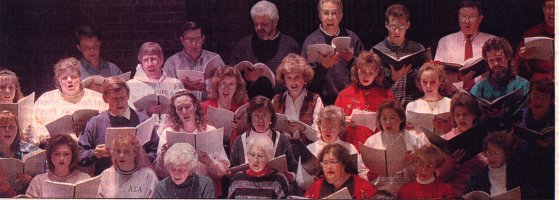by Carson P. Cooman, NewMusica
Return to Gwyneth Walker Home Page
Return to Gwyneth Walker Music Catalog
Return to Gwyneth Walker Recordings Page
Read notes for River Songs (1996) for SATB chorus and chamber orchestra
(Photograph of members of St. Joseph Community Chorus during a rehearsal for a 1996 performance of River Songs.)

There are few composers with the ability to bring together a total synthesis of traditional material and their own musical ideas. This 1996 work by American Gwyneth Walker displays that she very well may be the greatest living exponent of this art. Perhaps not since Aaron Copland has there been a composer who is able to combine traditional American songs and spirituals so integrally with his/her own material so as to make them be totally fresh and original -- without losing any of the power and flavor of the originals. Walker provides subtle modifications, amplifications, and repetitions of the words -- combined with her own distinctive and lush harmonizations, new melodies and countermelodies, and skillful orchestral accompaniment.
River Songs is an extensive cycle for mixed chorus and orchestra. Which each movement ranging from about five to eight minutes in duration, the entire cycle is approximately twenty minutes long. However, any of the movements could be excerpted and performed highly successfully on its own. An experienced composer for both chorus and orchestra, the choral and orchestral parts are manageable and very well-written. It is one of the very finest works for chorus and orchestra written by an American and the very finest settings of these traditional songs/spirituals.
The work of opens with a setting of the spiritual Deep River. It begins with murmured pulsations of the chorus as the singers speak (non-pitched and unsynchronized) names of rivers over and over again. This builds to the opening entrance of the chorus with the first phrase of the spiritual. The verses of the spiritual are treated (with much "river commentary" and word-painting from the orchestra) and lead back into a repetition of the opening "spoken river names" section.
The next song is a light-hearted and very fun setting of the traditional folk-song A Mule Named Sal. The humorous text is treated skillfully -- with judicious use of a number of colorful orchestral effects. Jazzy in feel and in harmonies, the piece includes a "scat singing" section near the end.
The final song, The Water is Wide, combines the traditional lyrics with a gorgeous new melody. The song opens with gentle pulsations (perhaps a small stream or a tributary), building up to lush and glorious climaxes as the verses of the song do. Finally, it dies away briefly before suddenly returning in a triumphant ending as the orchestra gives us the feel of a huge, massive rushing river. The ending is a truly stunning moment.
Altogether, it is an immensely satisfying piece that would be enjoyed by singers, orchestra, and audience alike -- totally fresh and original while still having a "point of recognition" in its creative use of traditional material.
Although the orchestral colors would, of course, be lost with a performance with piano, the work would still be successful. The piano version has been released by ECS Publishing (catalogue #5383, 5384, 5385). However, it might be an excellent opportunity for a chorus who has never worked with orchestra before to collaborate with a local orchestra in a performance of this work. A very fine live concert recording of it is available on the MaltedMedia label performed by the Montpelier Chamber Orchestra Society and the Sounding Joy! choir of Randolph, Vermont.
From the NewMusicaAutumn 2000